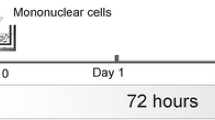Summary
Liver connective tissue cells (LCTC) isolated from patients with fibrotic livers have morphological and biochemical characteristics of myofibroblasts. We have examined the proliferation of LCTC derived from normal livers and from livers with fibrosis of different etiologies, as well as proliferation of skin fibroblasts. We have compared proliferation rates in the presence of fresh human serum and heat-inactivated serum. While skin fibroblast and LCTC from normal liver showed no difference, proliferation of LCTC from fibrotic livers was markedly decreased in the presence of heat-inactivated serum. We demonstrate that the native complement component C1 is a factor involved in the induction of DNA synthesis and proliferation of LCTC isolated from fibrotic livers. We propose that native C1, acting probably in cooperation with other growth factors, is involved in the expansion of connective tissue cells during the development of liver fibrosis.
Similar content being viewed by others
References
Andrade, Z. Hepatic schistosomiasis. Morphological aspects. In: Popper, H.; Schaffner, F., eds. Progress in liver disease. Vol. 2. New York: Grune & Stratton; 1965:228–242.
Bordin, S.; Page, R. C. Role of platelet factors and serum complement in growth of fibroblasts with high affinity C1q complement receptors. In Vitro Cell. Dev. Biol. 24:719–726; 1988.
Bordin, S.; Page, R. C.; Narayanan, A. S. Heterogeneity of normal adult fibroblasts: isolation and characterization of one phenotype. Science 223:171–173; 1984.
Borojevic, R.; Vinhas, S. A.; Monteiro, A. N. A., et al. Liver connective tissue cells isolated from human schistosomal fibrosis or alcoholic cirrhosis represent a modified phenotype of smooth muscle cells. Biol. Cell 53:231–238; 1985.
Bunchet, E.; Wake, K. Role of mesenchymal cell populations in porcine serum-induced rat liver fibrosis. Hepatology 16:1452–1473; 1992.
Gabbiani, G.; Majno, G.; Ryan, G. B. The fibroblast as a contractile cell: the myofibroblast. In: Kulonen, E.; Pikkarainen, J. eds. Biology of the fibroblast. New York: Academic Press; 1983:139–154.
Galambos, J. T.; Hollingsworth, M. A., Jr.; Falek, A., et al. The rate of synthesis of glycosaminoglycans and collagen by fibroblasts cultured from adult human liver biopsies. J. Clin. Invest. 60:107–114; 1977.
Grimaud, J. A.; Borojevic, R. Myofibroblasts in hepatic schistosomal fibrosis. Experientia 33:890–892; 1977.
Grimaud, J. A.; Borojevic, R. Chronic human schistosomiasis mansoni: pathology of the Disse’s space. Lab. Invest. 36:268–273; 1977.
Grimaud, J. A.; Borojevic, R. Portal fibrosis: intrahepatic portal vein pathology in chronic schistosomiasis mansoni. J. Submicroscop. Cytol. 18:783–793; 1986.
Korotzer, T. I.; Clagett, J. A.; Kolb, W. F., et al. Complement dependent induction of DNA synthesis and proliferation of human diploid fibroblasts. J. Cell Physiol. 105:503–512; 1980.
Miao, S.; Bao-En, W.; Annoni, G., et al. Two rat models of hepatic fibrosis. Lab. Invest. 63:467–475; 1990.
Monteiro, A. N. A.; Borojevic, R. In vitro formation of fibrous septa by liver connective tissue cells. In Vitro Cell. Dev. Biol. 23:10–14; 1987.
Monteiro, A. N. A.; Borojevic, R. Interaction of human liver connective tissue cells, skin fibroblasts and smooth muscle cells with collagen gels. Hepatology 7:665–671; 1987.
Narayanan, A. S.; Page, R. C. Connective tissue of the periodontium; a summary of current work. Coll. Rel. Res. 3:33–64; 1983.
Rudolph, R.; McClure, J. W.; Woodward, M. Contractile fibroblasts in chronic alcoholic cirrhosis. Gastroenterology 76:704–709; 1979.
Sama, S. K.; Bhargava, S.; Gopi-Nath, N., et al. Non-cirrhotic portal fibrosis. Am. J. Med. 51:161–169; 1971.
Schaffner, F.; Popper, H. Capillarization of hepatic sinusoids. Gastroenterology 44:239–242; 1963.
Voss, B.; Rauterberg, J.; Pott, G., et al. Non-parenchymal cells cultivated from explants of fibrotic liver resemble endothelial and smooth muscle cells from vessel walls. Hepatology 2:19–28; 1982.
Author information
Authors and Affiliations
Rights and permissions
About this article
Cite this article
Monteiro, A.N.A., Borojevic, R. Complement-dependent induction of DNA synthesis and cell proliferation in human liver connective tissue cells in vitro. In Vitro Cell Dev Biol - Animal 31, 149–155 (1995). https://doi.org/10.1007/BF02633975
Received:
Accepted:
Issue Date:
DOI: https://doi.org/10.1007/BF02633975



